June Bloye exemplifies the aspiring sculptor who has benefited a great deal from her involvement in NWSSA. This has allowed her to carve out a second career. She has, in turn, reciprocated by lending her talents to the association by serving as an active and vital board member. Her inspiring story follows.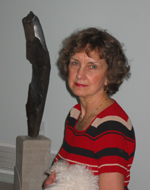
LE: Please introduce yourself, and tell us a little about how you were introduced to sculpture.
JB: I’m a person who has come late to art. Most of my life I’ve been a craft person, but now I see a continuum from one art form to another. Cutting out glass for stained glass panels taught me how to cut slate and other flat stones; jewelry making taught me how to manipulate and so on. The converse is also true. A recent project of mine involved appliqueing a scene onto the back of a fleece jacket, which I made 3-D from my sculpture experience. I think that all art forms complement each other. No craft making has been wasted and, in fact, most techniques have come in handy in one way or another. I now enjoy mixing my media so that I have stone with copper wire, glass, and wood. In the future I hope to combine other media as well.
I began carving stone in 1993 after we moved from Ontario to British Columbia because I saw some work I liked and was encouraged to give it a try myself. At the time, I wanted something to do outside because the summer was lovely, and I felt strange being in a new house. I picked up a small piece of soapstone and a tool of some sort from a toolbox, and away I went while my equally lonely dog kept me company. Shortly after that I tracked down a sculptor whose work I had seen in a local gallery and he helped me on and off for the next couple of years. It is to him that I owe my introduction to the NWSSA.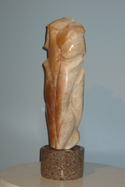
At the present time we don’t have a local sculpting group, but recently at our art meeting, three other stone carvers came to see what our society was all about. I think we were all pretty happy to see each other, so they joined and now we want to plan a get-together to share some ideas. I’ve spent the last two years as president of our local art society harping on anyone who would listen that art doesn’t have to hang on the wall, so maybe someone is finally listening!
LE: What are the sources of your sculptural ideas?
JB: I have always spent a lot of time outdoors so my inspiration comes from my many walks through the woods and along the shore. I see a bird, a duck, a plant, or just an interesting shape, and I store it in my mind until the next time I have a piece of stone that recalls that time. I would have to say that most of my work is natural. When I have a piece of stone I like, I put it up on a table in my studio so that I live with it for a period of time and then usually by the time I want to carve that stone, I know pretty well what it’s going to look like finished. Often, while walking my dog through the woods nearby, a picture flashes into my mind, and I know just what I want to carve. Usually, it ends up being very much like my vision. Occasionally, when I have to struggle with a stone, the carving does not go well, and the finished product is a disappointment.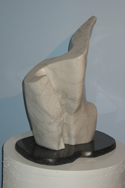
To keep my plans on track, I often put a large, rough drawing up on the bulletin board in front of me for reference when I can’t remember which way is up. I often find that I lose my bearings after a while and have to put the paper pattern onto the stone to bring it all back to mind. I have never used clay because it gets under my nails and I don’t like that. Sometimes I doodle when I watch TV and from those scribbles have come some pretty good ideas.
LE: What are you trying to express through your work?
JB: My environment is constantly changing and is a continuous source of inspiration. Who could not be touched by a whale swimming down the strait or a leaf falling from a tree? All around us nature is showing off her beauty and I feel a need to express that same beauty in my own way. One of my first successful pieces was a chlorite Orca whale jumping over a glass wave. That was my tribute to the first pod of whales we saw the first month we lived here. What a welcome! On an alabaster leaf I carved, I cut out the center and inserted copper wire that I antiqued with a patina to turn it green. I love the amount of green which surrounds me here. These two pieces are very special to me because they represent the feelings I have about living in this glorious place, the West coast.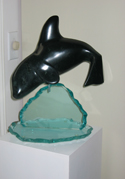
My reason for sculpting is not essentially to express any deep philosophy. I’m much too pragmatic for that, but if I can interpret my feelings about elements in nature around me, then I’m happy. Sometimes I don’t know what I’m doing, but after I’m finished, I know what I’ve done. Other people seem to get the point.
LE: Are you a full or part-time sculptor?
JB: Stone carving is not a full time occupation for me and I used to feel badly about that after I met people from the NWSSA. Now, after a few years, I just feel grateful that I can spend as much time as I do on it. Since I am a teacher from October to May, I have little time to work in my cozy studio, so I have to make the most of the summer months and snatched moments on some weekends. On this cold snowy day, (Dec. 30), I did turn up my heater and spent two hours outside finishing a piece I began last September on Thetis Island. That was my holiday treat to myself. The piece is orange alabaster flowers; it felt good to carve flowers in December. (Update: The alabaster flower is now in Taiwan waiting to be installed in a spa.)
LE: Please describe your studio.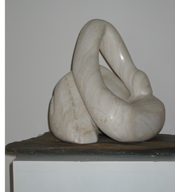
JB: My studio is a 10 x 10 room with lots of windows and two skylights. Being in the backyard is a mixed blessing but mostly I love it since I have all my creature comforts five paces from my own space. All of my tools and one of my rock piles are in there, so any time I want to just breathe the atmosphere, it’s not far to go. When I get that craving for dust, I walk out the door and just inhale, and then I know I’ll make it through the winter and enjoy another season of making dust. The garden tap is near by as well, so I often do my wet sanding on a little stand there. I also have the option of hanging the garden hose over my shoulder and grinding away on a piece of basalt. Neighbours are lovely so I don’t do that when they are out sweeping!
LE: What are your favorite stones?
JB: Alabaster seems strange to me now because I’ve spent the last several years working harder varieties such as basalt, hard marbles, and unknown road rocks. As a traveler around the province, I pick up whatever stones look interesting along the side of the road: sometimes this has proved fortuitous, and other times foolhardy. The last load was lovely pink stuff from Alberta, and should have been left there! It even wore out my diamond blade. At the moment my favorite stone is marble since it combines easy carvability with good edges and a fine polish, but since I usually have several pieces on the go all at different stages of development, they may be different types of stone as well. I go with whatever fascinates me at the time. Some would call that fickle!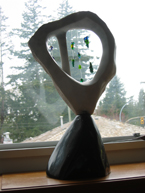
LE: What are your favorite tools?
JB: My favorite tool is my angle grinder since I can do everything from roughing out to final sanding. If the piece is small or has more detailed areas, I also use my die grinder with the flex shaft. It allows me to get into some very small areas on stone of any hardness. I recently made a dancing bear from a nameless stone I found in the park, but when I began working it, I found I could only cut with diamond bits! That little bear turned out to be an expensive project, so I keep it around to remind me not to bring home rocks from the park! She is a lovely bear, however, and I love her spirit.
I don’t work with hand tools as often as I would like to for two reasons: first, I find it hard on the shoulders, and second, I’m not very good at it. I find most hand carving teachers work on figures and that doesn’t interest me too much. What I would like to do is to learn hand carving on an abstract piece without ruining myself. If anybody can teach me that, I’d love to learn. So far, any time I have tried using hand tools, I end up with a large pile of dust and chips, but no sculpture, just a smaller piece of stone.
One of my essential tools is my drill press. I like pinning and sleeving according to Joanne Duby’s system so it comes in handy to get those holes lined up straight. I find customers are very impressed when they see the sculpture turn around so smoothly and once they do it themselves, they are hooked! What a technique! Thanks to you, Joanne.
LE: Do you exhibit your work?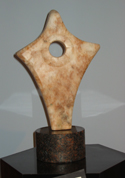
JB: Because my output is so small, perhaps five or six pieces a year, I don’t show at a gallery, but only in group shows, or juried shows in my own area. I belong to an art society here and we have several shows a year, but then I also enter juried art shows in the surrounding cities. I have a small showroom set up in my house now as well, so I sometimes have individuals or small groups in to view my work here. At a recent private viewing I sold more than I had in the previous two years, so I don’t have much to exhibit at the moment.
LE: What size of stones do you prefer to carve?
JB: My scale is limited to what I can reasonably carry, or someone in my family can lift! I have inadvertently made a few pieces that I have to call someone else to lift for me, and I don’t like that, so I’m working smaller now, about 40-50 pounds or a little less. I like the larger scale very much because I’m used to the arc of my angle grinder, but alas, time is not kind to the body. It’s been suggested by family members (don’t you just love them?) that I carve foam, but the situation isn’t that bad yet!
LE: What sorts of challenges have you faced?
JB: I wish I could say I had overcome all the challenges, but that would be a lie. Dust can blow away, techniques can be learned, ideas can be captured, but aches and pains are harder to ignore. I have learned to work in shorter spurts to prevent serious injury, but even that I learned the hard way. My studio is a is a great place for me to go to be close to the conveniences of home-with windows that open on all four sides, and two sky lights to bring in good light. I look out on my yard and garden with all the rhododendrons, lilies and poppies and how could I not feel inspired to create something beautiful. My radio further creates an atmosphere with lovely classical music. My greatest reward is having someone look at my work and say it is truly beautiful. What more could one ask (other than cash!)?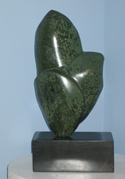
If time allows, I would love to learn more about metal so I could combine the two media together. I have done a few pieces with metal bases or legs, but I had to have that work done for me.
Perhaps my greatest challenge is overcoming the view of myself that I am not an artist. During my impressionable years, my teachers told me with varying degrees of tact, that my work didn’t rate being put up around the room. I had the misfortune of being in class with one boy whose work the teachers admired a little too much, so I was made to feel like a dope. For many years after that, I did nothing at all in the art field, and in fact knew I was incapable. It took a discussion at Camp Brotherhood one year to give me the confidence to think of my self as an artist even a little bit. I still struggle with that every time someone mentions the word “artist”.
LE: How has the NWSSA influenced you?
JB: This is a good time to thank all those people who made it possible for me to continue when I knew I was in way over my head. As a non-artist who came to Camp Brotherhood for the first year in 1995, I was welcomed anyway with open arms by Gwen Kleeman first, and then Meredith Earles and Rich Hestekind. Even though I was only there for three days that first time, and they could tell I knew nothing or less than that, they made me feel welcome and taught me enough to make me want to continue when I got home, and long for the day when I could return the following year. I remember driving home that year and wondering how I could possibly wait for a whole year to come back again to feel that warmth that I had never felt before. I recall it was a long year.
And then July came around again, and that time I was able to stay longer, but again, not long enough. That year I met more wonderful people, and they were different from any people I had ever met before! Oh, how they were different! Had I led a sheltered life? I guess so. But I went home and worked on my stone whenever I had the chance. I started to lobby for a studio at home but got nowhere. I had a history of starting hobbies of one kind and another and getting tired of them in a year or two. So, no studio for me.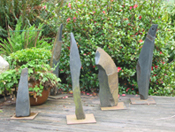
The next year I went back to Camp Brotherhood again, learned more, made more friends, came home, worked out in the rain and cold, and lo and behold, friends started to lobby for me to get that studio. The studio got built and the rest is history. The studio that was thought unnecessary, and probably short-lived as a stone studio, continues to function as such. It still isn’t a hot tub house (yes, that was plan B)!
To all of you who supported me along the way, thank you. Stone carving continues to nourish me in way I could never have imagined. I owe you and the craft a lot.
LE: What does the future hold for you?
JB: I hate to give away secrets, but I have a vision with slumped glass and white marble. A recent piece of mine with glass beads I made myself has given me several ideas of more works I want to do with coloured glass installed. I have always been inspired by Canada’s Group of Seven painters and all the brilliant colours they use. My dream would be to make a piece of sculpture, which similarly portrays the colour spectrum of autumn. This spring I am taking a class to give this a try. If my vision comes true, I’ll let you all know.
